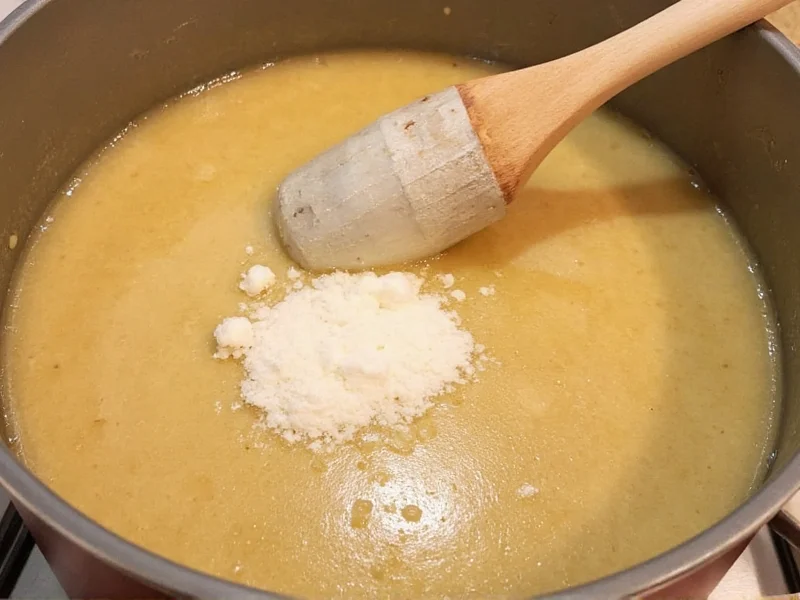Thickening soup properly with cornstarch requires understanding the right proportions and technique. Unlike flour, cornstarch has double the thickening power and creates a clear, glossy finish ideal for delicate soups and sauces. The key is preparing a smooth slurry and adding it at the correct temperature stage to activate cornstarch's thickening properties without causing clumping.
The Science Behind Cornstarch Thickening
Cornstarch works through starch gelatinization. When heated in liquid, cornstarch granules absorb water, swell, and eventually burst, releasing starch molecules that thicken the surrounding liquid. This process begins around 140°F (60°C) and completes near boiling point. Adding cornstarch directly to hot liquid causes immediate surface gelation, trapping dry starch inside and creating stubborn lumps that won't dissolve.
Perfect Cornstarch-to-Liquid Ratios
Getting the proportions right prevents under-thickened or gloppy results. The standard ratio works for most soups, but you may need adjustments based on desired consistency:
| Soup Volume | Cornstarch | Cold Liquid for Slurry | Expected Thickness |
|---|---|---|---|
| 2 cups | 1 tbsp | 2 tbsp | Light coating consistency |
| 4 cups | 2 tbsp | 4 tbsp | Medium body (standard) |
| 6 cups | 3 tbsp | 6 tbsp | Rich, velvety texture |
| 8 cups | 4 tbsp | 8 tbsp | Very thick, almost stew-like |
Step-by-Step Thickening Process
- Prepare your slurry: In a small bowl, combine 1 tablespoon cornstarch with 2 tablespoons cold liquid (water, broth, or reserved soup broth). Whisk until completely smooth with no visible granules.
- Bring soup to gentle simmer: Your soup should be hot but not boiling vigorously. Excessive boiling can break down the starch structure.
- Slowly incorporate slurry: While whisking soup continuously, gradually pour in the slurry. Add it in a thin, steady stream to prevent clumping.
- Cook to activate thickening: Continue simmering for 1-2 minutes after adding slurry. The soup will thicken noticeably as it returns to a gentle boil.
- Assess and adjust: If more thickness is needed, prepare additional slurry (never add dry cornstarch). Remember that soup continues thickening slightly as it cools.
Common Mistakes That Cause Lumpy Soup
Even experienced cooks encounter issues when thickening soup. These frequent errors explain why your cornstarch soup might turn out lumpy:
- Adding dry cornstarch directly to hot liquid - Causes instant surface gelation creating impenetrable lumps
- Using insufficient cold liquid in slurry - Too thick slurry doesn't incorporate smoothly
- Adding slurry to boiling soup - Vigorous bubbling prevents even distribution
- Not whisking continuously during incorporation - Allows slurry to settle and clump in one spot
- Over-thickening - Adding too much cornstarch creates an unappetizing, gluey texture
Troubleshooting Thickened Soup
Even with proper technique, issues can arise. Here's how to fix common problems:
If Your Soup Is Too Thin
Prepare additional slurry using the standard 1:2 ratio. For every cup of soup, use 1/2 to 1 teaspoon cornstarch with corresponding cold liquid. Whisk slurry into gently simmering soup and cook for 2 minutes. Remember that cornstarch reaches full thickness as it cools, so wait before adding more.
If Your Soup Is Too Thick
Gradually whisk in additional warm broth, water, or cream until desired consistency is reached. Add liquid in small increments (1-2 tablespoons at a time) to maintain control over the final texture. Avoid adding cold liquid directly to hot soup as it may cause separation.
If You Have Lumps
Remove soup from heat and let sit for 1 minute. Then vigorously whisk through a fine-mesh sieve into a clean pot. Alternatively, use an immersion blender on low setting to break up lumps without incorporating excess air. Prevention is always better than correction - proper slurry technique avoids this issue entirely.
Cornstarch vs. Alternative Thickeners
While cornstarch creates a clear, glossy finish ideal for Asian soups and delicate broths, other thickeners serve different purposes:
- All-purpose flour: Requires twice as much as cornstarch, creates opaque finish, needs cooking to eliminate raw flour taste
- Arrowroot: Similar to cornstarch but works better with acidic liquids and doesn't break down with prolonged cooking
- Roux: Cooked flour-fat mixture providing rich flavor but altering soup appearance and taste
- Pureed vegetables: Natural thickening with added nutrition but changes flavor profile
Cornstarch remains the best choice when you want to thicken soup without changing its appearance or flavor profile significantly.
Storage Considerations for Cornstarch-Thickened Soups
Soups thickened with cornstarch behave differently when stored compared to those thickened with flour. The starch structure breaks down during reheating, causing thinning. To maintain consistency:
- Store thickened soup in airtight containers for up to 4 days
- Reheat gently over medium-low heat, avoiding vigorous boiling
- Have additional slurry ready to restore thickness during reheating
- Freeze without thickener and add cornstarch when reheating frozen soup
Professional Chef Tips for Perfect Results
Seasoned cooks employ these advanced techniques when thickening soup with cornstarch:
- Reserve some broth before adding cornstarch to create your slurry for better flavor integration
- For cream soups, mix cornstarch with the cold dairy component before adding to hot soup
- Acidic soups (tomato-based) require slightly more cornstarch as acid inhibits thickening
- Never add cornstarch during the last 5 minutes of cooking acidic soups
- For restaurant-quality shine, strain soup through chinois after thickening











 浙公网安备
33010002000092号
浙公网安备
33010002000092号 浙B2-20120091-4
浙B2-20120091-4